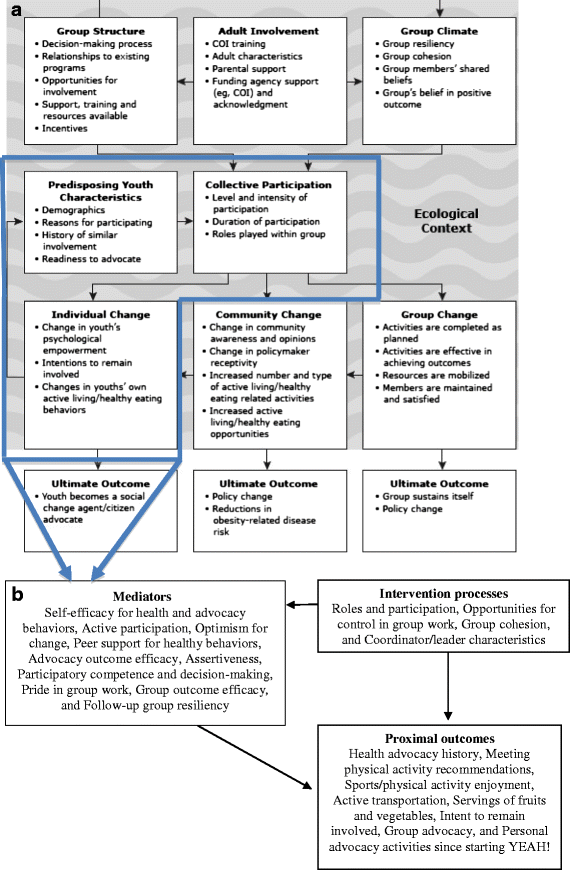Development of measures to evaluate youth advocacy for obesity prevention
- PMID: 27461189
- PMCID: PMC4962448
- DOI: 10.1186/s12966-016-0410-x
Development of measures to evaluate youth advocacy for obesity prevention
Abstract
Background: Youth advocacy has been successfully used in substance use prevention but is a novel strategy in obesity prevention. As a precondition for building an evidence base for youth advocacy for obesity prevention, the present study aimed to develop and evaluate measures of youth advocacy mediator, process, and outcome variables.
Methods: The Youth Engagement and Action for Health (YEAH!) program (San Diego County, CA) engaged youth and adult group leaders in advocacy for school and neighborhood improvements to nutrition and physical activity environments. Based on a model of youth advocacy, scales were developed to assess mediators, intervention processes, and proximal outcomes of youth advocacy for obesity prevention. Youth (baseline n = 136) and adult group leaders (baseline n = 47) completed surveys before and after advocacy projects. With baseline data, we created youth advocacy and adult leadership subscales using confirmatory factor analysis (CFA) and described their psychometric properties.
Results: Youth came from 21 groups, were ages 9-22, and most were female. Most youth were non-White, and the largest ethnic group was Hispanic/Latino (35.6%). The proposed factor structure held for most (14/20 youth and 1/2 adult) subscales. Modifications were necessary for 6 of the originally proposed 20 youth and 1 of the 2 adult multi-item subscales, which involved splitting larger subscales into two components and dropping low-performing items.
Conclusions: Internally consistent scales to assess mediators, intervention processes, and proximal outcomes of youth advocacy for obesity prevention were developed. The resulting scales can be used in future studies to evaluate youth advocacy programs.
Keywords: Adolescent; Built environment; Food environment; Physical activity environment; Psychometrics.
Figures

Similar articles
-
A pilot study evaluating the effects of a youth advocacy program on youth readiness to advocate for environment and policy changes for obesity prevention.Transl Behav Med. 2016 Dec;6(4):648-658. doi: 10.1007/s13142-016-0408-6. Transl Behav Med. 2016. PMID: 27246954 Free PMC article.
-
Youth advocacy as a tool for environmental and policy changes that support physical activity and nutrition: an evaluation study in San Diego County.Prev Chronic Dis. 2014 Mar 27;11:E46. doi: 10.5888/pcd11.130321. Prev Chronic Dis. 2014. PMID: 24674636 Free PMC article.
-
SaludableOmaha: development of a youth advocacy initiative to increase community readiness for obesity prevention, 2011-2012.Prev Chronic Dis. 2012;9:E173. doi: 10.5888/pcd9.120095. Prev Chronic Dis. 2012. PMID: 23217590 Free PMC article.
-
Youth advocacy for obesity prevention: the next wave of social change for health.Transl Behav Med. 2011 Sep;1(3):497-505. doi: 10.1007/s13142-011-0060-0. Transl Behav Med. 2011. PMID: 24073069 Free PMC article. Review.
-
Reducing obesity and related chronic disease risk in children and youth: a synthesis of evidence with 'best practice' recommendations.Obes Rev. 2006 Feb;7 Suppl 1:7-66. doi: 10.1111/j.1467-789X.2006.00242.x. Obes Rev. 2006. PMID: 16371076 Review.
Cited by
-
Evaluation of a Large-Scale School Wellness Intervention Through the Consolidated Framework for Implementation Research (CFIR): Implications for Dissemination and Sustainability.Front Health Serv. 2022 Apr 28;2:881639. doi: 10.3389/frhs.2022.881639. eCollection 2022. Front Health Serv. 2022. PMID: 36925836 Free PMC article.
-
A pilot study evaluating the effects of a youth advocacy program on youth readiness to advocate for environment and policy changes for obesity prevention.Transl Behav Med. 2016 Dec;6(4):648-658. doi: 10.1007/s13142-016-0408-6. Transl Behav Med. 2016. PMID: 27246954 Free PMC article.
-
Engaging older adults as advocates for age-friendly, walkable communities: The Senior Change Makers Pilot Study.Transl Behav Med. 2021 Sep 15;11(9):1751-1763. doi: 10.1093/tbm/ibab098. Transl Behav Med. 2021. PMID: 34293156 Free PMC article. Clinical Trial.
-
How Youth of Color Create Communities of Hope: Connecting Advocacy, Activity, and Neighborhood Change.Int J Environ Res Public Health. 2021 Mar 18;18(6):3133. doi: 10.3390/ijerph18063133. Int J Environ Res Public Health. 2021. PMID: 33803686 Free PMC article.
-
Perceptions and Impact of a Youth-led Childhood Obesity Prevention Intervention among Youth-leaders.J Hunger Environ Nutr. 2021;16(2):213-234. doi: 10.1080/19320248.2019.1649777. Epub 2019 Aug 5. J Hunger Environ Nutr. 2021. PMID: 34539947 Free PMC article.
References
Publication types
MeSH terms
LinkOut - more resources
Full Text Sources
Other Literature Sources
Medical
Research Materials

